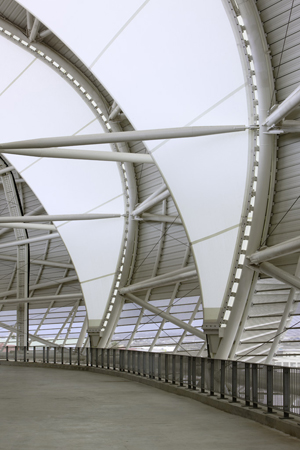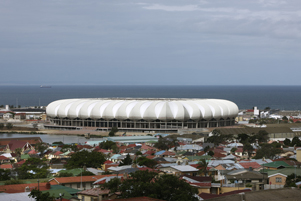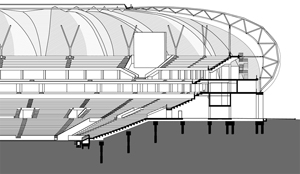 |
 |
 |
 |
 |
 |
| |
 |
|
 |
 |
 |
  |
  |
 |
 |
 |
 |
|
|
 |
|
 |
 |
 |
BUILDING |
 |
|
 |
|
 |
 |
 |
| |
 |
| 
 |
Nelson Mandela Bay Stadium
|
|
 |
 |
 |
 |
DESIGNER |
 |
|
|
 |
|
 |
 |
 |
| |
 |
|
 |
 |
 |
 |
DESCRIPTION |
 |
|
|
 |
|
 |
 |
 |
|
|
 |
 Designed as a football and rugby stadium, the Nelson Mandela Bay Stadium is located beside North End Lake with terraces and hills in the middle of Prince Alfred’s Park. Designed as a football and rugby stadium, the Nelson Mandela Bay Stadium is located beside North End Lake with terraces and hills in the middle of Prince Alfred’s Park.
The stadium is set in the surrounding area as a landmark building, rising from the edge of the lake like a flower. Located right beside the lake, the building is reflected in the water and forms a unique vista.
 The silhouette of the stadium indicates the clear design of the structural members. They form a colonnaded walkway that encloses the whole stadium. The glazed lounge level forms the horizontal termination of the colonnades. The leaf-shaped roof components, the tips of which extend as far as the floor at lounge level, float above this ring and round the picture off. The silhouette of the stadium indicates the clear design of the structural members. They form a colonnaded walkway that encloses the whole stadium. The glazed lounge level forms the horizontal termination of the colonnades. The leaf-shaped roof components, the tips of which extend as far as the floor at lounge level, float above this ring and round the picture off.
The roof structure is oriented to local climate conditions and protects spectators not only against the sun but also (and particularly) against frequent, violent onshore winds. The protection takes the form of aluminum cladding carried on triangulated trusses with white PTFE membrane surfaces in the interstices. All technical facilities such as the sound system and lighting, and also the maintenance walkway, are integrated into the roof.
The stadium is designed for 48,000 spectators divided into an upper and a lower level. The rounded design of the stands provides optimum viewing conditions and guarantees an intimate, emotional atmosphere.
The design takes account not only of function, technical and climatic aspects but also cultural considerations as well. The façade, which is at the rear of the colonnading, is being finished by local African craftsmen to give a 700m-wide exhibition of traditional and modern African culture.
The construction of the Nelson Mandela Bay Stadium offers an opportunity to provide Port Elizabeth with a high-quality sports facility that will revitalize the whole urban area. The aim of the design is to encourage maximum use after the World Cup. All the press areas of the stadium can be turned into offices and leisure facilities. An open area will be created between the stadium and the sea offering water-based recreation. Along with the sports and leisure clubs in Port Elizabeth that will use the stadium on a daily basis, the area around Prince Alfred’s Park will develop into an excursion destination. |
|
 |
 |
 |
|
 |
|
|
|
 |
|
 |
 |
 |
 |
 |
 |
 |
MATERIALS |
 |
|
|
 |
|
 |
 |
 |
 |
 |
|
reinforced concrete  Number of pre-cast terrace units: 5301 Number of pre-cast terrace units: 5301
Concrete volume / reinforcement in terrace units: 6735 m³ / 810 t
Number of pre-cast raker beams: 208
Concrete volume / reinforcement in raker beams: 2279 m³ / 347 t
Number of pre-cast stair wells: 416
Concrete volume / reinforcement in pre-cast units: 1412 m³ / 85 t
Number of in-situ columns: 756
Concrete volume / reinforcement in columns: 3338 m³ / 514 t
Number of piles: 1188
Concrete volume / reinforcement in piles: 4035 m³ / 242 t
Description of roof structure:
36 main girders, formed by 3-dimensional triagonal trusses, are cantelevered over the stands, cladded with aluminium panels, partially peforated. PTFE-membrane panels span between the 36 main girders, tightened by valley cables that devide each membrane panel in 2 segments.
Structural steel tonnage: 2000 t
Aluminum cladding surface: 22.500 m²
Membrane surface: 22.000 m²
Number of bolted nodes: 1404
Dimensions: 266 x 207 m
Depth: 45 m
Height: 25 m
|
|
 |
 |
 |
 |
LOCATION |
 |
|
|
 |
|
 |
 |
 |

|
 |

|
Continent |
|
 |
  Afrique |
|
Nation |
|
 |
  South Africa [Suid Afrika] |
|
Province |
|
 |
  Eastern Cape |
|
Municipality |
|
 |
  Nelson Mandela Bay |
|
Town |
|
 |
  Port Elizabeth |
|
Address |
|
 |
  Lake View Road
|
|
|
|
 |
|
 |
 |
 |
 |
MAP |
 |
|
|
 |
|
 |
 |
 |
| |
 |
|
 |
 |
 |
 |
|
TYPOLOGY |
 |
|
|
 |
|
 |
 |
 |
|
|
 |
ARCHITECTURE | Sports buildings
Stadiums, grandstands
| |
 |
 |
 |
 |
CHRONOLOGY |
 |
|
|
 |
|
 |
 |
 |
Project |
 |
|
 |
| 
 |
2005
|
|
Realisation |
 |
|
 |
| 
 |
2007 - 2009 |
|
 |
 |
 |
 |
EXHIBITIONS |
 |
|
|
 |
|
 |
 |
 |
| |
 |
| From Cape Town to Brasília. New Sports Stadiums by the Architects von Gerkan, Marg und Partner, München, Pinakothek der Moderne, Architekturmuseum der Technischen Universität, 22 april/20 june 2010 |
|
 |
 |
 |
 |
 |
 |
 |
CLIENT |
 |
|
|
 |
|
 |
 |
 |
| |
 |
| Nelson Mandela Bay Municipality |
|
 |
 |
 |
 |
AMOUNT |
 |
|
|
 |
|
 |
 |
 |
| |
 |
| ZAR 1.600.000.000 / € 120.000.000 |
|
 |
 |
 |
 |
DIMENSIONAL
DATA |
 |
|
|
 |
|
 |
 |
 |
| Capacity |
 |
|
 |
46.000 permanent seats
48.600 including temporary seats
2.390 business seats
125 permanent seats for press
46 VIP-Boxes
96 underground parking |
|
| Lenght |
 |
|
 |
|
| Widht |
 |
|
 |
|
 |
 |
 |
 |
STAFF |
 |
|
|
 |
|
 |
 |
 |
|
 |
|
Project architect |
 |
| Volkwin Marg and Hubert Nienhoff with Holger Betz |
|
Associate architect |
 |
|
Project leader |
 |
| Holger Betz, Silke Flaßnöcker |
|
Design team |
 |
| Burkhard Pick, Martin Krebes, Margret Böthig, Robert Hormes, Alberto Flores, Tobias Schaer |
|
General contractor |
 |
| Grinaker LTA / Interbeton |
|
Design consortium |
 |
| BKS/BTKM-PMSA in co-operation with ADA Architectural Design Associates, Dhiro Kalian, Dominic Bonnesse Architects, NOH Architects, Gapp Architects |
|
 |
 |
 |
 |
ANNOTATIONS |
 |
|
|
 |
|
 |
 |
 |
| |
 |
Matches:
- 12 June Group B Korea Republic - Greece
- 15 June Group G Côte d'Ivoire - Portugal
- 18 June Group D Germany - Serbia
- 21 June Group H Chile - Switzerland
- 23 June Group C Slovenia - England
- 26 June Round of 16 1A - 2B
- 02 July Quarter-finals W53 - W54
- 10 July Match for third place L61 - L62

See dossier South Africa, FIFA World Cup 2010

See other dossiers Stadi, Sudafrica 2010 |
|
 |
 |
 |
 |
CREDITS |
 |
|
|
 |
|
 |
 |
 |
| |
 |
Photos © Marcus Bredt
Drawings © gmp von Gerkan, Marg und Partner
Text edited by gmp von Gerkan, Marg und Partner
Courtesy by gmp von Gerkan, Marg und Partner
|
|
 |
  |
 |
|
|